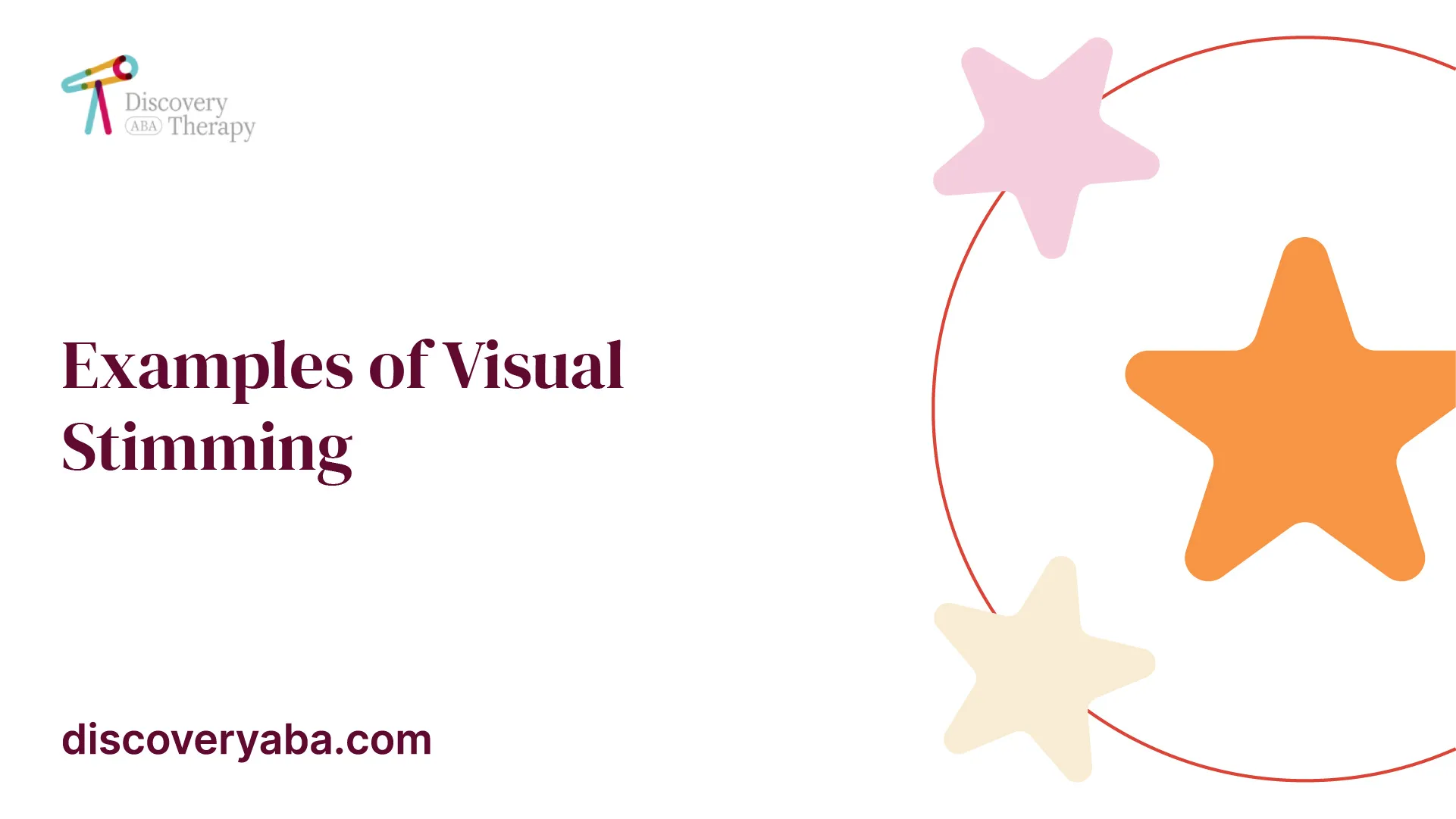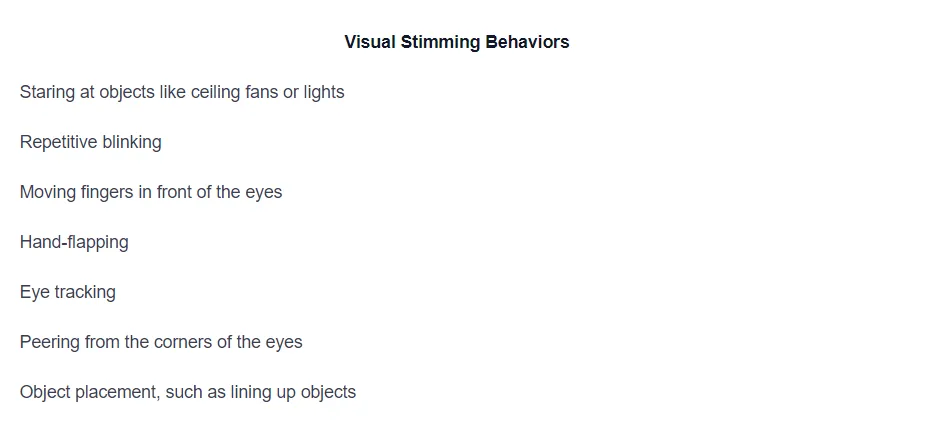Examples of Visual Stimming
Discover the power of visual stimming! From managing anxiety to expressing emotions, explore captivating examples and strategies.

Understanding Visual Stimming
Visual stimming, also known as self-stimulation or stereotypy, refers to repetitive behaviors that involve visual stimuli. These behaviors can serve various purposes, including providing sensory stimulation, reducing anxiety, expressing emotions, and adapting to different environments. Examples of visual stimming behaviors include staring at lights, spinning objects, hand-flapping, and looking at moving objects.
Definition and Characteristics
Stimming is a term often associated with autism spectrum disorder (ASD). The Diagnostic and Statistical Manual of Mental Disorders (DSM-5) includes stimming as part of the diagnostic criteria for ASD, defining it as "stereotyped or repetitive motor movements, use of objects, or speech" [2]. However, it's important to note that stimming behaviors can be present in individuals without autism as well.
Visual stimming behaviors involve actions such as looking at lights for a prolonged period or frequently blinking or rolling the eyes. These behaviors can manifest in various ways and differ from person to person. Some individuals may engage in repetitive eye movements, while others may focus on specific visual stimuli.

Common Examples
Visual stimming behaviors can vary widely, but there are several commonly observed examples. These behaviors may include:
- Staring at objects: Some individuals with visual stimming tendencies may fixate on objects such as ceiling fans, lights, or other visually stimulating items. This prolonged focus on specific visual stimuli provides sensory stimulation and can be soothing for the individual.
- Repetitive blinking: Blinking one's eyes repeatedly is another visual stimming behavior that individuals may engage in. This action can provide a sense of visual stimulation and help regulate sensory input.
- Hand-flapping: Hand-flapping involves repeatedly opening and closing one's hands, often done in a rapid and repetitive manner. This behavior can serve as a way to self-soothe, express excitement, or release excess energy.
- Eye tracking: Eye tracking refers to the repetitive movement of the eyes, often involving shifting the gaze from one point to another or following the movement of objects. This behavior can provide visual stimulation and help the individual regulate sensory input.
- Object placement: Some individuals may engage in visual stimming by arranging or lining up objects in a specific order. This behavior allows for visual organization and can provide a sense of control and comfort.
It's important to recognize that visual stimming behaviors can vary greatly from person to person. What may be a common example for one individual may not be present in another. Understanding and respecting individual differences is essential when considering visual stimming behaviors.
By understanding the definition and characteristics of visual stimming and being aware of common examples, we can gain insights into this self-stimulatory behavior and its role in the lives of individuals who engage in it.
Reasons for Visual Stimming
Visual stimming behaviors serve various purposes, providing individuals with a range of benefits. Understanding the reasons behind visual stimming can help us appreciate its significance and support individuals who engage in these behaviors. The main reasons for visual stimming include coping with sensory overload, managing anxiety, and expressing emotions.
Coping with Sensory Overload
One of the primary reasons for visual stimming is to cope with sensory overload. For individuals with conditions such as Autism Spectrum Disorder (ASD), ADHD, and sensory processing disorders, the world can be overwhelming due to heightened sensitivity to sensory stimuli. Visual stimming behaviors help regulate sensory input and provide a sense of control in overwhelming environments. Examples of visual stimming behaviors include staring at lights, spinning objects, or looking at moving objects.
By engaging in visual stimming, individuals can redirect their attention and focus on visual stimuli that provide comfort or familiarity. This self-soothing mechanism helps them navigate challenging sensory situations, reducing feelings of distress and improving their overall well-being.
Managing Anxiety
Visual stimming also plays a crucial role in managing anxiety. The repetitive nature of visual stimming behaviors can have a calming effect on individuals, helping to alleviate anxiety and promote a sense of relaxation. These behaviors serve as a form of self-regulation, allowing individuals to regain control and find comfort in their surroundings.
In situations that elicit anxiety, individuals may engage in visual stimming as a way to redirect their focus and reduce feelings of unease. For instance, a person with autism might repetitively flip a toy in their hand to self-regulate when feeling overwhelmed in a crowded and noisy environment. By engaging in visual stimming, individuals can effectively cope with uncomfortable or stressful situations, ultimately improving their emotional well-being.
Expressing Emotions
Visual stimming can also act as a means of expressing emotions, particularly in individuals who may struggle with verbal communication. These behaviors serve as nonverbal cues, allowing individuals to convey their needs, discomfort, or emotions. Caregivers and individuals in their social environment should be attentive to these visual cues and interpret them appropriately to provide the necessary support.
By engaging in visual stimming behaviors, individuals can express joy, excitement, frustration, or other emotions they may find challenging to communicate verbally. It is essential to recognize and respect these nonverbal forms of expression, fostering understanding and acceptance of individuals who rely on visual stimming as a means of emotional communication.
Understanding the reasons behind visual stimming behaviors empowers us to provide appropriate support and create inclusive environments. By recognizing the benefits of visual stimming in coping with sensory overload, managing anxiety, and expressing emotions, we can promote acceptance and well-being for individuals who engage in these behaviors.
Visual Stimming in Different Contexts
Visual stimming can be observed in various contexts, including children with autism and adults engaging in stimming behaviors.
Children with Autism
Stimming behaviors, including visual stimming, are commonly observed in children with autism. These behaviors serve as coping mechanisms to stimulate the senses, adapt to unfamiliar environments, reduce anxiety, express frustration, or avoid certain activities or expectations.
Visual stimming behaviors in children with autism can manifest in different ways. Some examples include:

These behaviors allow children with autism to regulate their sensory experiences and find comfort in their surroundings [4]. It is important to note that visual stimming in children with autism serves various purposes and can vary from one child to another. Understanding and supporting these behaviors can contribute to their overall well-being and development.
Adults and Stimming
While stimming is often associated with children, it is not limited to a specific age group. Adults with autism or other neurodivergent conditions may also engage in stimming behaviors, including visual stimming.
Visual stimming behaviors in adults can vary greatly, as individuals develop their own unique ways of self-stimulation and sensory regulation. Some may continue to engage in behaviors observed during childhood, while others may develop new forms of visual stimming that suit their needs and preferences.
Stimming behaviors in adults can serve similar purposes as in children, such as managing sensory overload, reducing anxiety, and expressing emotions. It is important to recognize and respect these behaviors as a natural part of an individual's neurodivergent experience.
By understanding and accepting visual stimming in different contexts, we can create a more inclusive and supportive environment for individuals with autism and other neurodivergent conditions.
Positive and Negative Aspects
When examining visual stimming behaviors, it is important to consider both the positive and negative aspects associated with them. Visual stimming can bring several benefits, but there are also challenges and concerns that need to be addressed.
Benefits of Visual Stimming
Visual stimming behaviors serve various purposes, providing individuals with benefits that aid in their self-regulation and overall well-being. Some of the benefits of visual stimming include:
- Sensory Stimulation: Engaging in visual stimming can provide sensory input, which can be calming and soothing for individuals. Examples of visual stimming behaviors include staring at lights, spinning objects, hand-flapping, and looking at moving objects [1].
- Anxiety Reduction: Visual stimming can help individuals manage anxiety and stress levels. By focusing on visually stimulating objects or patterns, they may find relief from overwhelming emotions and achieve a sense of calm.
- Emotional Expression: Visual stimming can serve as a form of nonverbal communication, allowing individuals to express their needs or discomfort. Caregivers and individuals in their social environment should understand and interpret these visual cues to provide appropriate support.
- Adapting to Environments: Visual stimming can help individuals adapt to different environments by providing a means of self-regulation. It allows them to create a sense of familiarity and control in unfamiliar or overwhelming situations.
Challenges and Concerns
While visual stimming can offer significant benefits, it is crucial to recognize and address the challenges and concerns associated with these behaviors. Some considerations include:
- Social Acceptance: Engaging in visual stimming behaviors may draw unwanted attention or be considered unusual or disruptive in certain social settings. This can lead to feelings of self-consciousness or social isolation.
- Disruptive Effects: In some instances, visual stimming may interfere with daily activities or tasks, making it challenging to focus or participate fully in certain environments. Managing these effects is important to ensure individuals receive appropriate support and can engage in activities effectively.
- Misinterpretation: Visual stimming behaviors can be misinterpreted by others who may not understand their purpose or significance. This misinterpretation can lead to misunderstandings or inappropriate responses from those who are unfamiliar with visual stimming.
To support individuals who engage in visual stimming, it is essential to strike a balance between promoting the benefits while addressing the challenges and concerns. Understanding and managing the negative aspects of visual stimming can contribute to creating inclusive environments that respect and accommodate individual needs and preferences. Sensory integration techniques, such as creating a sensory-friendly environment and providing sensory activities, can help individuals with visual stimming address their sensory needs and manage sensory overload. By doing so, individuals can experience the positive benefits of visual stimming while minimizing any potential challenges.
Strategies for Managing Visual Stimming
For individuals who engage in visual stimming, there are strategies that can help manage and channel this behavior in a positive and productive way. Two key approaches include sensory integration techniques and developing emotional expression skills.
Sensory Integration Techniques
Sensory integration techniques aim to address the sensory needs of individuals who engage in visual stimming, helping them manage sensory overload and promote sensory regulation. These techniques can be beneficial in reducing the need for excessive visual stimming. Some examples of sensory integration techniques include:
- Creating a sensory-friendly environment: Designing spaces that are tailored to the individual's sensory preferences can provide a calming and comfortable atmosphere. This may involve adjusting lighting, reducing background noise, and incorporating sensory elements such as textured surfaces or calming scents.
- Providing sensory activities: Engaging in sensory activities can help individuals regulate their sensory experiences. Activities such as deep pressure stimulation, use of fidget toys, or engagement with sensory bins can provide alternative sensory input and promote self-regulation.
By incorporating sensory integration techniques into daily routines, individuals with visual stimming behaviors can find effective ways to manage their sensory needs and reduce the reliance on visual stimming as a coping mechanism.
Emotional Expression Skills
Developing emotional expression skills is crucial for individuals who engage in visual stimming, particularly those with autism who may struggle with recognizing, interpreting, and expressing emotions. By enhancing emotional expression abilities, individuals can better navigate their emotions and reduce the need for visual stimming as a means of emotional regulation. Some strategies to develop emotional expression skills include:
- Social stories: Social stories provide individuals with narratives that help them understand and respond to different social situations. They can be used to teach emotional recognition, regulation, and appropriate responses to emotional cues.
- Role-playing: Engaging in role-playing activities allows individuals to practice recognizing and expressing emotions in a safe and controlled environment. This can enhance their emotional expression skills and build confidence in managing their emotions.
- Teaching emotional regulation techniques: Introducing techniques such as deep breathing, mindfulness, or guided imagery can help individuals develop effective strategies for calming themselves during times of emotional distress. These techniques can enhance emotional expression skills and provide alternative means of managing emotions.
By focusing on improving emotional expression skills, individuals with visual stimming behaviors can develop a broader range of coping mechanisms and effectively express their emotions in more adaptive ways.
By implementing sensory integration techniques and fostering the development of emotional expression skills, individuals with visual stimming behaviors can find healthier ways to manage their sensory needs and emotional well-being. It's important to remember that these strategies should be tailored to the individual's specific needs and preferences, and may require ongoing support and guidance from professionals, caregivers, and educators.
Supporting Individuals with Visual Stimming
When it comes to supporting individuals who engage in visual stimming behaviors, it's important to provide intervention and support strategies to help them manage their sensory needs and promote overall well-being. Additionally, creating a sensory-friendly environment can play a significant role in minimizing triggers and fostering a comfortable space for individuals with visual stimming behaviors.
Intervention and Support Strategies
Intervention and support strategies can help individuals with visual stimming address their sensory needs and manage sensory overload. These strategies aim to promote sensory regulation and reduce the need for excessive visual stimming. Some effective intervention and support strategies for individuals with visual stimming include:
- Sensory Integration Techniques: Sensory integration techniques involve creating a sensory-friendly environment and providing sensory activities tailored to the individual's needs. This can include offering sensory breaks, incorporating calming sensory elements like weighted blankets or fidget toys, and providing opportunities for sensory exploration and stimulation. Employing these techniques can help individuals find alternative ways to meet their sensory needs, reducing reliance on visual stimming behaviors.
- Emotional Expression Skills: Improving emotional expression skills is crucial for individuals with visual stimming behaviors, particularly those with autism. Strategies such as social stories, role-playing, and teaching emotional regulation techniques can support individuals in enhancing their emotional expression abilities. By developing these skills, individuals can better recognize, interpret, and express their emotions, potentially reducing the need for visual stimming as a coping mechanism.
Creating a Sensory-Friendly Environment
Creating a sensory-friendly environment is essential for individuals with visual stimming behaviors to feel comfortable and supported. A sensory-friendly environment minimizes overwhelming stimuli and provides a space that caters to the individual's sensory needs. Some key considerations for creating a sensory-friendly environment include:
- Lighting: Adjusting lighting levels to reduce glare and harsh lighting can be beneficial for individuals with visual stimming behaviors. Using soft, natural lighting or dimming lights can create a more soothing environment.
- Sound: Minimizing excessive background noise or providing noise-cancelling headphones can help individuals focus and reduce auditory sensory overload.
- Textures and Surfaces: Incorporating a variety of textures and surfaces in the environment can offer different tactile sensations and opportunities for sensory exploration. This can include soft cushions, textured rugs, or smooth surfaces.
- Organization and Structure: Establishing clear and predictable routines, as well as maintaining an organized physical space, can help individuals with visual stimming behaviors feel more secure and in control.
- Visual Supports: Utilizing visual supports such as visual schedules, visual timers, and visual cues can assist individuals in understanding and following routines, promoting a sense of structure and reducing anxiety.
By implementing these strategies and creating a sensory-friendly environment, individuals with visual stimming behaviors can feel more supported and empowered. These interventions and environmental adaptations can contribute to their overall well-being and help them navigate their sensory experiences more effectively.
References
- https://www.webmd.com/brain/autism/what-you-need-to-know-about-stimming-and-autism
- https://www.nimh.nih.gov/health/topics/autism-spectrum-disorders-asd
- https://www.cdc.gov/autism/index.html
- https://www.ncbi.nlm.nih.gov/pmc/articles/PMC7082249/
- https://www.medicalnewstoday.com/articles/319714
- https://www.yellowbusaba.com/post/stimming-in-autism
- https://www.nhs.uk/conditions/autism/autism-and-everyday-life/help-with-behaviour/
Does Your Child Have An Autism Diagnosis?
Learn More About How ABA Therapy Can Help
Find More Articles
Contact us
North Carolina, Nevada, Utah, Virginia
New Hampshire, Maine
Arizona, Colorado, Georgia, New Mexico, Oklahoma, Texas
.avif)


































































































